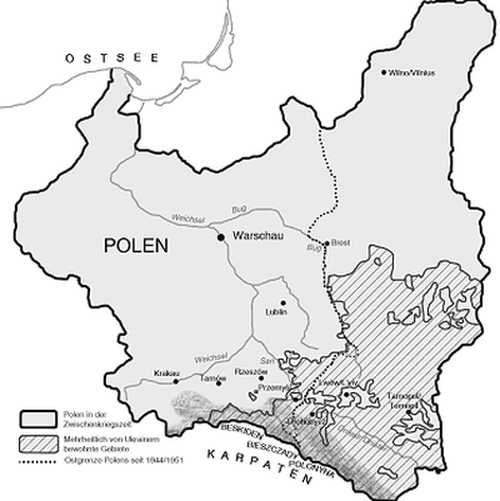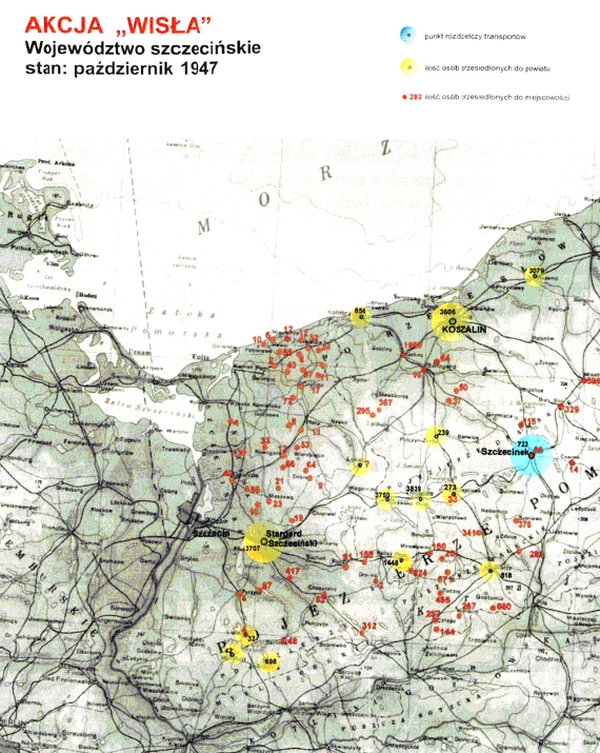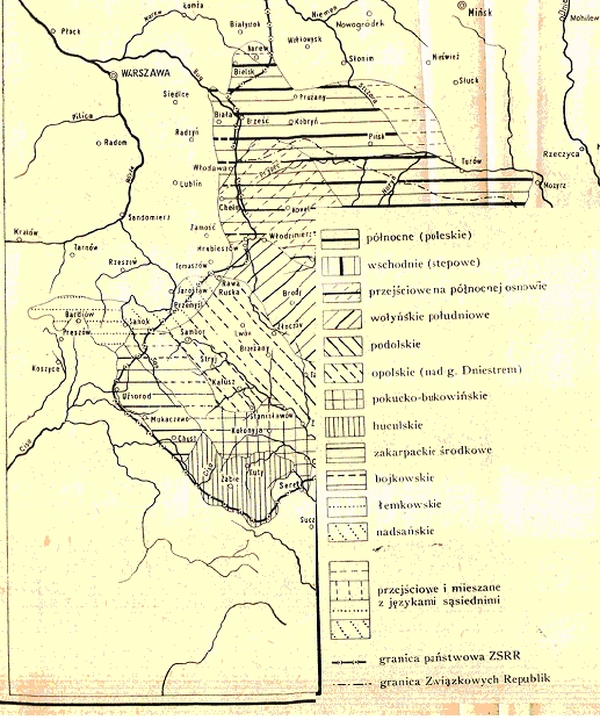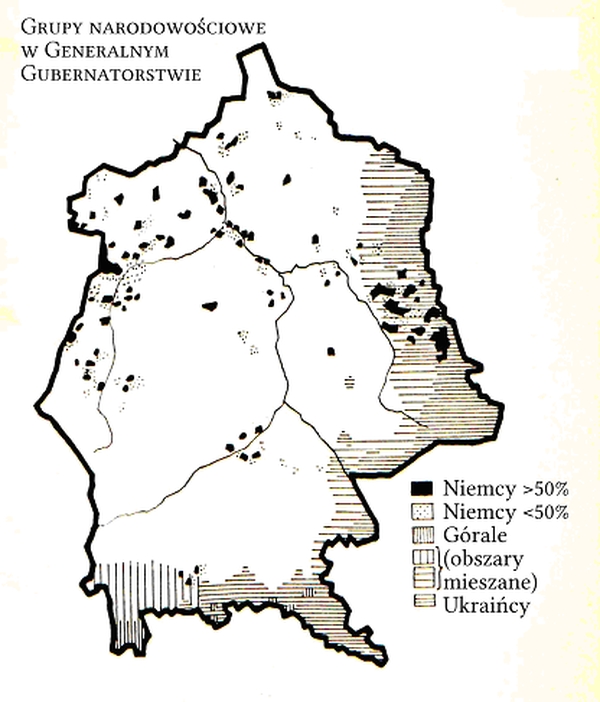ukraińskie gwary
Nazwa
Współcześnie endolingwonim określający język ukraiński to украïнська мова. Po polsku mówi się o języku ukraińskim; w języku rosyjskim, należącym do jednego z częściej używanych na Ukrainie, nazwa tego języka brzmi украинский язык, zaś w języku angielskim – Ukrainian.Historia nazwy
Najdawniejsze nazewnictwo dotyczące ukraińskiego i ogólnie wschodniosłowiańskiego obszaru kulturowego związane jest z etnonimem Ruś (słowiańskie Рѹсь). W tym kontekście wschodniosłowiański język tego obszaru nazywano ruskim (руський язик).Patriarchat Konstantynopolitański rozróżniał na Rusi od XIV w.: Μικρὰ Ῥωσσία (z greckiego – języka Patriarchatu Konstantynopola – Mała Ruś), obejmującą Metropolię Halicką, oraz Μεγάλη Ῥωσσία (grecki Wielka Ruś), obejmującą Metropolię Kijowską. Z czasem całą Ukrainę zaczęto określać Małą Rusią, a język – małoruskim bądź małorosyjskim (малоросійська мова, малоруська мова, малоруський язик).
Nazwa Ukraina najprawdopodobniej pochodzi od praindoeuropejskego rdzenia *krei ‘ciąć’, podobnie jak inne słowiańskie wyrazy związane ze skrajem, czy też krajaniem. Najstarsze pisemne wzmianki nt. Ukrainy zaświadczone są w tekście Powieści dorocznej (staroruska kronika Повесть временных лет – Powiest' wriemiennych liet) w jej wersji zawartej w Kodeksie Ipatijewskim. Kronikarz, odnotowując pod 1187 r. śmierć księcia Włodzimierza Pierejesławskiego, wspomniał, że „za nim ukraina wielce rozpaczała”. Słowo występuje w Powieści dorocznej jeszcze kilkakrotnie, ale oznacza zawsze po prostu pogranicze – nie stanowi zaś nazwy własnej żadnego konkretnego obszaru. To ostatnie znaczenie pojawiło się dopiero w XVI-wiecznych źródłach polskich: początkowo Ukrainą nazywano obszar województwa kijowskiego, z czasem wraz z województwami bracławskim i czernihowskim. Od XVII w. nazwy Ukraina na oznaczenie swojej ojczyzny używali Kozacy, choć raczej w sensie poetyckim, jako pogranicze. W tym samym czasie termin pojawił się też na Zachodzie. Dzisiejsze znaczenie słowa Ukraina jako nazwy obszaru zamieszkanego przez Ukraińców datuje się na początek XIX w., kiedy zaczął się rozwijać ruch narodowy. Terytorium takiej Ukrainy pozostawało jednak nadal niesprecyzowane, ponieważ pod władzą austriacką i rosyjską administracyjne wydzielenie Ukrainy nie było możliwe. Dopiero w 1917 r. po nazwę tę dla oznaczenia bardzo konkretnych tworów geopolitycznych sięgnęły zarówno Ukraińska Republika Ludowa, Hetmanat (Państwo Ukraińskie) oraz bolszewicy, którzy utworzyli Ukraińską Socjalistyczną Republikę Radziecką (Magocsi 2010: 189-190
 Magocsi 2010 / komentarz/comment/r /
Magocsi 2010 / komentarz/comment/r / Magocsi, Paul Robert 2010. A History of Ukraine. Toronto: University of Toronto Press.
 ). Od tego czasu należy datować powszechną akceptację terminu jako określenia (mniej lub bardziej suwerennego) państwa (Fałowski 2011: 127-128
). Od tego czasu należy datować powszechną akceptację terminu jako określenia (mniej lub bardziej suwerennego) państwa (Fałowski 2011: 127-128 Fałowski 2011 / komentarz/comment/r /
Fałowski 2011 / komentarz/comment/r / Fałowski, Adam 2011. „Język ukraiński”, w: Barbara Oczkowa & Elżbieta Szczepańska (red.) Słowiańskie języki literackie. Rys historyczny. Kraków: UJ, s. 127-144.
 ).
).Nazwy odmian używanych w Polsce
Nazwę надсянській говір (gwara nadsańska) wprowadził prawdopodobnie Iwan Ziłynski w 1933 r. – przyjęła się ona w obiegu naukowym jeszcze przed II wojną światową (Łesiw 1997: 151 Łesiw 1997 / komentarz/comment/r /
Łesiw 1997 / komentarz/comment/r / Лесів, Михайло [Łesiw] 1997. Украïнські говірки у Польщі. Варшава: Украïнський Архів.
 ). Wśród alternatywnych określeń rzeczownikowych Michał Łesiów wymienia Надсяння, Посяння oraz Надсянщина (Łesiw 1997: 153
). Wśród alternatywnych określeń rzeczownikowych Michał Łesiów wymienia Надсяння, Посяння oraz Надсянщина (Łesiw 1997: 153 Łesiw 1997 / komentarz/comment/r /
Łesiw 1997 / komentarz/comment/r / Лесів, Михайло [Łesiw] 1997. Украïнські говірки у Польщі. Варшава: Украïнський Архів.
 ). Funkcjonuje także określenie долівський говір, wywodzące się od nazwy долиняни (Dolinianie), jaką Łemkowie określali mieszkańców okolic Przemyśla (ukr. Перемишль) i Jarosławia (Ярослав).
). Funkcjonuje także określenie долівський говір, wywodzące się od nazwy долиняни (Dolinianie), jaką Łemkowie określali mieszkańców okolic Przemyśla (ukr. Перемишль) i Jarosławia (Ярослав). Gwary naddniestrzańskie nazywano także opolskimi, od nazwy Opola (ukr. Опілля) – wyżyny na zachodniej Ukrainie, stanowiącej część Wyżyny Podolskiej (ukr. Подільська височина). Istnieje też rzeczownikowe określenie Наддністрянщина.
Gwary wołyńsko-chełmskie Władysław Kuraszkiewicz dzieli na gwary o charakterze poludniowo-ruskim; do linii od Hrubieszowa (ukr. Грубешів) aż pod Zamość (Замостя) na północy oraz ikające gwary północno-ruskie, przejściowe do południowo-ruskich; do linii od Włodawy (ukr. Володава) aż pod Łęczną (ukr. Ленчна). Niektórzy autorzy określają je po prostu gwarami wołyńskimi (волинські говірки) albo chełmskimi (холмські говірки, Холмщина). Ze względu na lokalizację w dawnej guberni lubelskiej pisano też o gwarach lubelskich (люблинські говірки) (Łesiw 1997: 239-242, 252
 Łesiw 1997 / komentarz/comment/r /
Łesiw 1997 / komentarz/comment/r / Лесів, Михайло [Łesiw] 1997. Украïнські говірки у Польщі. Варшава: Украïнський Архів.
 ).
).Różnego rodzaju dialekty wpisujące się we wschodniosłowiańskie kontinuum bywają nazywane językiem chachłackim (ros. хохлатский язык) (np. Łesiw 1997: 249
 Łesiw 1997 / komentarz/comment/r /
Łesiw 1997 / komentarz/comment/r / Лесів, Михайло [Łesiw] 1997. Украïнські говірки у Польщі. Варшава: Украïнський Архів.
 ). Określenie to odnosi się również do dialektów podlaskich, które choć bywają opisywane jako odmiany języka ukraińskiego, to w ramach niniejszego portalu omówione zostały odrębnie. Ponadto określenia Chachły, chachłacki są pejoratywnymi określeniami odnoszącymi się do Ukraińców i języka ukraińskiego na obszarze postsowieckim.
). Określenie to odnosi się również do dialektów podlaskich, które choć bywają opisywane jako odmiany języka ukraińskiego, to w ramach niniejszego portalu omówione zostały odrębnie. Ponadto określenia Chachły, chachłacki są pejoratywnymi określeniami odnoszącymi się do Ukraińców i języka ukraińskiego na obszarze postsowieckim.Historia i geopolityka
Lokalizacja w Rzeczypospolitej
Terytorium Rzeczypospolitej Obojga Narodów aż do ugody perejasławskiej (1654 r.) obejmowało większą część obszaru ukraińskich odmian językowych.Przed II wojną światową dialektami ukraińskimi posługiwano się na znacznym obszarze Polski południowo-wschodniej (por. mapkę).

Mapa występowania mniejszości ukraińskiej w okresie międzywojennym (za: Jähnig 2008
 Jähnig 2008 / komentarz/comment/r /
Jähnig 2008 / komentarz/comment/r / Jähnig, Georg 2008. „Medien der Minderheiten – Ukrainer in Polen, Polen in Litauen”, w: Stefan Daute & Adrian Fiedler (red.) Slavische nationale Minderheiten im Ostseeraum. Potsdam: Universitätsverlag Potsdam, s. 77-81.
 ).
).Określenie gwary nadsańskie odnosi się do ukraińskich odmian językowych z obszaru nad Sanem, od rzeki Strwiąż na południu aż do rzeki Tanew na północy. Terytorium to należy w większej części do obecnego województwa podkarpackiego, częściowo dochodzi też do obwodu lwowskiego na Ukrainie. W II Rzeczypospolitej był to obszar powiatów: przemyskiego i jarosławskiego, zachodnich fragmentów mościskiego, jaworowskiego i lubaczowskiego, a także południowej części powiatu biłgorajskiego. Mówcy gwar nadsańskich zamieszkiwali okolice miast: Przemyśl (ukr. Перемишль), Sanok (Сянік), Jarosław (Ярослав), Berezów (obecnie miasto Березів na Ukrainie), Radymno (Радuмно), Tarnogród (Терногород), Przeworsk (Переворськ), Leżajsk (Лєжайск), Lubaczów (Любачів) (Łesiw 1997: 151
 Łesiw 1997 / komentarz/comment/r /
Łesiw 1997 / komentarz/comment/r / Лесів, Михайло [Łesiw] 1997. Украïнські говірки у Польщі. Варшава: Украïнський Архів.
 ).
). Obszar gwar naddniestrzańskich znajduje się na pograniczu województw podkarpackiego (gminy Horyniec – ukr. Горинець, Cieszanów – Чешанів i Narol – Наріль) i lubelskiego (gminy Lubycza Królewska – ukr. Любича-Королівська, Jarczów – Ярчів/Конвиця i Ulhówek – Вільгівок).
Na terenie Polski gwary zachodniowołyńskie występują lub występowały w trzech powiatach województwa lubelskiego: hrubieszowskim, tomaszowskim i zamojskim.
Dalej na północ pojawiają się gwary przechodnie w kierunku gwar północnoukraińskich (poleskich). Tego typu odmiany językowe spotyka się w powiecie chełmskim.
Z powodu przymusowych przesiedleń mówcy dialektów ukraińskich znaleźli się także na terenie Polski północnej i zachodniej. Znaczne skupiska stworzyli na Dolnym Śląsku, Pomorzu, Warmii i Mazurach, a także w wielkich miastach, głównie w Warszawie i Krakowie (Wicherkiewicz 2000: 188
 Wicherkiewicz 2000 / komentarz/comment/r /
Wicherkiewicz 2000 / komentarz/comment/r / Wicherkiewicz, Tomasz 2000. „Tożsamość mniejszości językowych w Rzeczypospolitej Polskiej”, w: T. Kostyrko, T. Zgółka (red.) Kultura wobec kręgów tożsamości. Materiały konferencji przedkongresowej Poznań 19-21 października 2000. Poznań-Wrocław.
 ).
). Oprócz ludności ukraińskiej ze wschodnich terenów powojennej Polski, gwarami ukraińskimi posługiwała się przesiedlona z ZSRR ludność uznana za polską. W tej ostatniej grupie znaleźli się też Ukraińcy (Słabig 2009: 180
 Słabig 2009 / komentarz/comment/r /
Słabig 2009 / komentarz/comment/r / Słabig, Arkadiusz 2009. „Inwigilacja ludności ukraińskiej na Pomorzu Zachodnim w latach 1947-1989 na podstawie dokumentów organów bezpieczeństwa”, w: Jarosław Syrnyk (red.) Aparat bezpieczeństwa Polski Ludowej wobec mniejszości narodowych i etnicznych oraz cudzoziemców. Warszawa: IPN, s. 180-202.
 ). Ponadto wg danych z 1952 r. w Szczecinie osiedlili się ukraińscy reemigranci z Argentyny i Brazylii (Słabig 2009: 180
). Ponadto wg danych z 1952 r. w Szczecinie osiedlili się ukraińscy reemigranci z Argentyny i Brazylii (Słabig 2009: 180 Słabig 2009 / komentarz/comment/r /
Słabig 2009 / komentarz/comment/r / Słabig, Arkadiusz 2009. „Inwigilacja ludności ukraińskiej na Pomorzu Zachodnim w latach 1947-1989 na podstawie dokumentów organów bezpieczeństwa”, w: Jarosław Syrnyk (red.) Aparat bezpieczeństwa Polski Ludowej wobec mniejszości narodowych i etnicznych oraz cudzoziemców. Warszawa: IPN, s. 180-202.
 ). Gwarę wołyńską na Pomorzu Zachodnim omawia np. Danuta Jarczak (1972
). Gwarę wołyńską na Pomorzu Zachodnim omawia np. Danuta Jarczak (1972 Jarczak 1972 / komentarz/comment/r /
Jarczak 1972 / komentarz/comment/r / Jarczak, Danuta 1972. „Niektóre osobliwości przemieszczonej gwary ukraińskiej w powiecie stargardzkim województwa szczecińskiego”, Zeszyty Naukowe 6: 41-54. Szczecin: Uniwersytet Poznański im. Adama Mickiewicza. Wyższa Szkoła Nauczycielska w Szczecinie.
 ).
).Pomimo że obszar ten pozostaje słabo zbadany, użytkownicy ukraińskich odmian językowych obecni są także w województwie lubuskim (Zielińska 2012: 13
 Zielińska 2012 / komentarz/comment/r /
Zielińska 2012 / komentarz/comment/r / Zielińska, Anna et al. 2012. „Wielojęzyczność w województwie lubuskim. Stan współczesny”, w: Beata A. Orłowska i Krzysztof Wasilewski (red.) Mniejszości regionu pogranicza polsko-niemieckiego. Gorzów Wielkopolski: Państwowa Wyższa Szkoła Zawodowa, s. 13-23.
 ).
).
Mniejszość ukraińska na Pomorzu Zachodnim przesiedlona w wyniku Akcji „Wisła” (za: Karwowska 2011: 210
 Karwowska 2011 / komentarz/comment/r /
Karwowska 2011 / komentarz/comment/r / Karwowska, Iwona 2011. „Mniejszość ukraińska w województwie zachodniopomorskim w świetle wystawy Ukraińcy na Pomorzu Zachodnim 1947-2007 w Muzeum Narodowym w Szczecinie”, w: Artur Kijas (red.) Ukraińcy – historia i kultura. Szreniawa: Muzeum Narodowe Rolnictwa i Przemysłu Rolno-Spożywczego, s. 208-218.
 ).
).
Mniejszości narodowe w Polsce w latach 1990-1998 (za: Matelski 1999: 274
 Matelski 1999 / komentarz/comment/r /
Matelski 1999 / komentarz/comment/r / Matelski, Dariusz 1999. Niemcy w Polsce w XX wieku. Warszawa-Poznań: PWN.
 ).
).Część odmian opisywanych często jako ukraińskie w ramach tego portalu omówiona jest odrębnie („Profil rusińsko-łemkowski”, „Profil gwar podlaskich i poleskich”).

Ukraińskie odmiany językowe na obszarze nadgranicznym (na podstawie: Kuraszkiewicz 1963
 Kuraszkiewicz 1963 / komentarz/comment/r /
Kuraszkiewicz 1963 / komentarz/comment/r / Kuraszkiewicz, Władysław 1963. Zarys dialektologii wschodniosłowiańskiej. Warszawa: PWN.
 ).
).Inne lokalizacje
Język ukraiński używany jest także w: Rosji, na Białorusi, w Mołdawii, Kazachstanie, Czechach, Słowacji, Węgrzech, Rumunii, Serbii, Chorwacji, w Kanadzie, USA, krajach Ameryki Południowej, Australii (Fałowski 2011: 127 Fałowski 2011 / komentarz/comment/r /
Fałowski 2011 / komentarz/comment/r / Fałowski, Adam 2011. „Język ukraiński”, w: Barbara Oczkowa & Elżbieta Szczepańska (red.) Słowiańskie języki literackie. Rys historyczny. Kraków: UJ, s. 127-144.
 ).
).Część mówców gwar ukraińskich z terenu Polski, uznanych za Ukraińców, deportowano po II wojnie światowej na teren Ukraińskiej SSR. Pomimo że deportowanych kierowano do wschodnich obwodów republiki, osoby te z czasem przeniosły się bliżej polskiej granicy. Cechami przyniesionymi z powiatów chełmskiego i jarosławskiego charakteryzuje się gwara wsi Hajowe (ukr. Гайове, Wołyń, Ukraina, dawna polska kolonia Przebraże) (Lisna 2001: 91
 Lisna 2001 / komentarz/comment/r /
Lisna 2001 / komentarz/comment/r / Лісна, Людмила [Lisna] 2001. „Холмські и перемиські діалектизми у мовленииі переселенців”, w: Feliks Czyżewski & Hryhorij Arkuszyn (red.) Ukraińskie i polskie gwary pogranicza. Lublin-Łuck: Polskie Towarzystwo Ludoznawcze, s. 91-94.
 ). Odmianę nadsańską odnotowano też w mieście Borysław (Борислав) w obwodzie lwowskim (Łesiw 1997: 194
). Odmianę nadsańską odnotowano też w mieście Borysław (Борислав) w obwodzie lwowskim (Łesiw 1997: 194 Łesiw 1997 / komentarz/comment/r /
Łesiw 1997 / komentarz/comment/r / Лесів, Михайло [Łesiw] 1997. Украïнські говірки у Польщі. Варшава: Украïнський Архів.
 ). Deportowanych nazywa się na Wołyniu Zabużanami (збужани) albo Chołmszczakami (Холмщаки) (Karaszczuk 2001: 105
). Deportowanych nazywa się na Wołyniu Zabużanami (збужани) albo Chołmszczakami (Холмщаки) (Karaszczuk 2001: 105 Karaszczuk 2001 / komentarz/comment/r /
Karaszczuk 2001 / komentarz/comment/r / Каращук, Ганна [Karaszczuk] 2001. „Волинь и польщизна”, w: Feliks Czyżewski & Hryhorij Arkuszyn (red.) Ukraińskie i polskie gwary pogranicza. Lublin-Łuck: Polskie Towarzystwo Ludoznawcze, s. 103-109.
 ).
). Historia
Obszar z tradycyjną obecnością odmian języka ukraińskiego stanowiła w średniowieczu przede wszystkim Ruś Czerwona. W 981 r. jako część Grodów Czerwieńskich Włodzimierz Wielki włączył ziemie na południe od rzeki Włodawki do Rusi Kijowskiej. Później zmieniały one przynależność polityczną, aby od XIII w. stać się częścią (ruskiego) księstwa chełmsko-bełskiego (Czyżewski i Warchoł 1998: VI Czyżewski i Warchoł 1998 / komentarz/comment/r /
Czyżewski i Warchoł 1998 / komentarz/comment/r / Czyżewski, Feliks & Stefan Warchoł 1998. Polskie i ukraińskie teksty gwarowe ze wschodniej Lubelszczyzny. Lublin: Wydawnictwo UMCS.
 ). Król Rusi Daniel Halicki (ukr. Даніло Галицький, lata życia 1201-1264) uczynił miasto Chełm (ukr. Холм) swoją stolicą.
). Król Rusi Daniel Halicki (ukr. Даніло Галицький, lata życia 1201-1264) uczynił miasto Chełm (ukr. Холм) swoją stolicą. Stabilizacja granicy polsko-ukraińskiej między Bugiem i Wisłą nastąpiła w XIV w. (Czyżewski i Warchoł 1998: VII
 Czyżewski i Warchoł 1998 / komentarz/comment/r /
Czyżewski i Warchoł 1998 / komentarz/comment/r / Czyżewski, Feliks & Stefan Warchoł 1998. Polskie i ukraińskie teksty gwarowe ze wschodniej Lubelszczyzny. Lublin: Wydawnictwo UMCS.
 ), kiedy w 1387 r. ziemia chełmska przypadła Polsce. Ukrainę przyłączono do Korony Królestwa Polskiego wskutek unii lubelskiej (1569 r.) – aktu tworzącego Rzeczpospolitą Obojga Narodów.
), kiedy w 1387 r. ziemia chełmska przypadła Polsce. Ukrainę przyłączono do Korony Królestwa Polskiego wskutek unii lubelskiej (1569 r.) – aktu tworzącego Rzeczpospolitą Obojga Narodów. Unie lubelska (1569 r.) i brzeska (1596 r.) zapoczątkowały polonizację szlachty. Językiem polskim obok ukraińskiego posługiwały się też kościelne elity intelektualne wykształcone w szkołach unickich (Czyżewski i Warchoł 1998: XI
 Czyżewski i Warchoł 1998 / komentarz/comment/r /
Czyżewski i Warchoł 1998 / komentarz/comment/r / Czyżewski, Feliks & Stefan Warchoł 1998. Polskie i ukraińskie teksty gwarowe ze wschodniej Lubelszczyzny. Lublin: Wydawnictwo UMCS.
 ).
). Na wschodzie obszar Ukrainy, pozostający pod polską kontrolą, zmniejszył się w wyniku ugody perejasławskiej (1654 r.), wówczas przywódcy ukraińskich Kozaków oddali się pod protekcję państwa moskiewskiego. W okresie zaborów pozostały obszar ukraińskojęzyczny znajdował się w granicach Austrii (później Królestwa Galicji i Lodomerii w ramach monarchii Habsburgów) i Rosji.
W zaborze austriackim cerkiew unicka nie została zlikwidowana, jednak nadal trwał proces polonizacji. Ludność unicka często znała i język polski, i ukraiński. Rodziny małżeństw mieszanych kultywowały równocześnie polski i ukraiński język oraz kulturę (Czyżewski i Warchoł 1998: XVIII
 Czyżewski i Warchoł 1998 / komentarz/comment/r /
Czyżewski i Warchoł 1998 / komentarz/comment/r / Czyżewski, Feliks & Stefan Warchoł 1998. Polskie i ukraińskie teksty gwarowe ze wschodniej Lubelszczyzny. Lublin: Wydawnictwo UMCS.
 ).
).W 1918 r. Chełmszczyzna (ukr. Холмщина) została przez Polskę odstąpiona Ukrainie (pokój brzeski), ale w wyniku traktatu ryskiego włączono ją ostatecznie do Polski (Łesiw 1997: 244
 Łesiw 1997 / komentarz/comment/r /
Łesiw 1997 / komentarz/comment/r / Лесів, Михайло [Łesiw] 1997. Украïнські говірки у Польщі. Варшава: Украïнський Архів.
 ).
).W okresie międzywojennym, po początkowym przyznaniu ludności ukraińskiej pewnych swobód, przywileje stopniowo ograniczano, np. likwidując szkoły i zamykając cerkwie (Łesiw 1997: 244-245
 Łesiw 1997 / komentarz/comment/r /
Łesiw 1997 / komentarz/comment/r / Лесів, Михайло [Łesiw] 1997. Украïнські говірки у Польщі. Варшава: Украïнський Архів.
 ).
).Po II wojnie światowej część ludności ukraińskojęzycznej znalazła się na zachód od granicy Polski i Ukrainy (wchodzącej wówczas w skład ZSRR). Po początkowych przesiedleniach na wschód (w latach 1945-1946 przesiedlono 483 tysięcy Ukraińców), w 1947 r. w ramach Akcji „Wisła” przeprowadzono przymusową deportację ludności ukraińskiej do innych rejonów Polski (zwłaszcza na wcielone do Polski nowe ziemie). Według oficjalnych danych na ziemie północne i zachodnie przesiedlono ponad 140 tysięcy Ukraińców (Łesiw 1997: 5-6, 159
 Łesiw 1997 / komentarz/comment/r /
Łesiw 1997 / komentarz/comment/r / Лесів, Михайло [Łesiw] 1997. Украïнські говірки у Польщі. Варшава: Украïнський Архів.
 ).
).
Grupy narodowościowe w Generalnym Gubernatorstwie (za: Arlt 1940: 97
 Arlt 1940 / komentarz/comment/r /
Arlt 1940 / komentarz/comment/r / Arlt, Fritz 1940. Die ukrainische Volksgruppe im Generalgouvernement. Krakau: Arlt.
 ).
).Kod ISO
ISO 639-1 uk
ISO 639-2 ukr
ISO 639-3 ukr
SIL UKR
W The Linguascale (klasyfikacji języków opracowanej przez L’Observatoire Linguistique) wszystkie odmiany ukraińskie obejmuje kod: 53-AAA-ed.
ISO 639-2 ukr
ISO 639-3 ukr
SIL UKR
W The Linguascale (klasyfikacji języków opracowanej przez L’Observatoire Linguistique) wszystkie odmiany ukraińskie obejmuje kod: 53-AAA-ed.
- przyp01
- Karaś 1975
- Tekst ustawy w literackim języku ukraińskim
- Magocsi 2010
- Fałowski 2011
- Łesiw 1997
- Jähnig 2008
- Słabig 2009
- Jarczak 1972
- Zielińska 2012
- Karwowska 2011
- Matelski 1999
- Kuraszkiewicz 1963
- Lisna 2001
- Karaszczuk 2001
- Czyżewski i Warchoł 1998
- Arlt 1940
- Lewis 2009
- Snyder 2006
- Czyżewski 1993
- Czubinski 1877
- Matelski 2012
- Łesiów 1997
- Warchoł 1992
- List of declarations 2012
- Słabig 2012
- Syrnyk i Wicherkiewicz 2006
- Kossakowska 2007
- Bobryk 2011
- Własowski 1961
- Misijuk 2012
- Prystasz 2011
- Czyżewski i Sajewicz 1997
- Czyżewski 1986
- Bandriwski et al. 1988
- MRS 2012
- Syrnyk [rok?]
- Wicherkiewicz 2000
- zagrożenie języków / language endangerment
- Mapa mniejszości ukraińskiej IIRP
- Mniejszość ukraińska na Pomorzu Zachodnim
- Mniejszości narodowe w Polsce w latach 1990-1998
- Ukraińskie odmiany na obszarze nadgranicznym
- Grupy narodowościowe w Generalnym Gubernatorstwie
- Akcja „Wisła”
- Podręcznik, materiały do grupowego samokształcenia
- Ogłoszenia w języku ukraińskim w Lubaczowie
- Dwujęzyczna tablica katedry w Przemyślu
- Herb „Płastu”
- Banner promujący Ukraiński Jarmark Młodzieżowy
- Dialekty ukraińskie